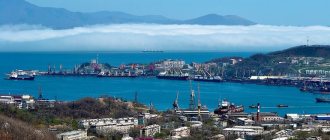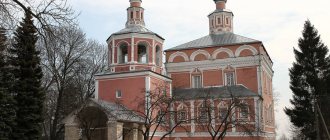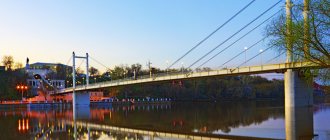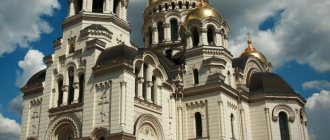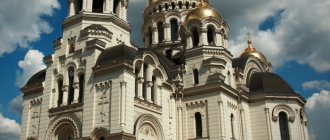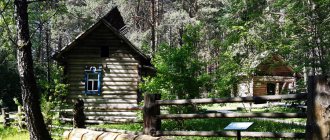Although Nevinnomyssk is small in area, this did not stop it from being divided into many districts. When I moved here, I had no problem understanding the intricacies of the city’s administrative division within the third or fourth day.
It looks like this:
- Center,
- PRP,
- spare parts,
- Head,
- MZhK,
- Red Village,
- Comet,
- Mill,
- Old city,
- Rozhdestvenka,
- Pravokubansky,
- House of life
- Factory.
On the map I marked the most important districts of Nevinnomyssk.
I’ll tell you in more detail about some of the most interesting areas to visit.
Museum of Local Lore
The gallery was opened in May 1957 as the "Combat Hall of Fame". After this, the museum changed its educational focus several times, and in 1978 a new building was allocated for it. Since 1994, it has been located in the central part of the city in the former building of the House of Celebrations.
The museum consists of three halls. The first is dedicated to the history of the city’s development, from the first settlers to modern Nevinnomyssk. In the second hall various art exhibitions are constantly held, and in the third there is an exhibition on the theme of the Great Patriotic War.
Location: Gagarin street - 43B.
Kingdom of water and greenery
Summers in Nevinnomyssk are hot and winters are mild. This climate is called temperate continental. Since there is a lot of water and heat here, the surroundings of the city are surrounded by greenery. The most precipitation falls in May, June and August. The least is in January and February. The hottest period is July-August. The air at this time warms up to +28 degrees. It is coldest from December to February, but the cold here is conditional, since the temperature fluctuates around zero. In the coldest years it did not fall below -7 degrees.
City outskirts
The city is crossed by two waterways - Kuban and Bolshoy Zelenchuk. The length of Kuban reaches 870 kilometers! It originates on Elbrus in Karachay-Cherkessia and carries its waters to the Sea of Azov. It’s hard to believe, but along its entire length, 14 thousand large, small and very small tributaries flow into the river! It is curious that after Nevinnomyssk the right tributaries completely disappear. The width of the river in the urban area reaches from 50 to 100 meters. There are several large islands in the channel. The largest has dimensions of 1800x500 meters.
The Bolshoi Zelenchuk River is significantly inferior to the Kuban. Its length is only 158 kilometers. It originates near the village of Arkhyz and flows into the Kuban in Nevinnomyssk. In the upper reaches, along the left bank, stretches the Teberda Nature Reserve. On the river there is the Zelenchukskaya hydroelectric station, which is considered the largest in the North Caucasus. The earthen dam is 670 meters long and 12 meters high. The hydroelectric complex forms a small reservoir. The width of the river within Nevinnomyssk ranges from 20 to 100 meters.
"Book of Memory"
The obelisk is made in the form of a book almost 3 m high and 13 m wide. On the pages of the book, made of stone, are engraved the names of almost 500 Soviet soldiers, most of whom were local residents who died in the war for the defense and free life of the city of Nevinnomyssk. The monument was opened in 2000 on the 55th anniversary of the celebration of the victory over the Nazi invaders.
On the Innocent Cape
The city of Nevinnomyssk is located in the Ciscaucasia, 70 kilometers south of Stavropol. From a geographical point of view, the area is called the Stavropol Upland. Urban development stretches along the left bank of the Bolshoi Zelenchuk River and the right bank of the Kuban River. The internal floodplain area between the rivers is not built up and is a forested area. This is a favorite vacation spot for city residents.
There are two main versions regarding the history of the origin of the city's name. The first belongs to the military historian Vasily Potto. More than a hundred years ago, he studied the Mozdok archive and discovered a circular dated 1784. It followed from it that the river flowing into the Kuban was ordered to be called Innocent. It already had a name given by the soldiers, but it sounded obscene. Later, a village was founded on the cape, at the confluence of the Nevinnaya River and the Kuban. The name Nevinnomyssk was assigned to it.
The author of the second version is the Stavropol local historian V. Kolesnikov, who wrote the book “The Past of the Innocent Cape”. In his opinion, the name of the settlement was given by Count Pavel Potemkin in 1784. The reason was the nearby mountain "Aryuv-kyz". Translated from Nogai it means “beautiful girl”. There is a legend associated with the mountain, according to which an innocent girl died after being married to an unloved man.
"Eternal Glory"
This monument was opened in November 1967, on the day of the 50th anniversary of the October Revolution, in the very center of the city. It, like the “Book of Memory,” is dedicated to the soldiers who died during the Second World War, as well as during the First World War. On the day of the opening of the monument, a capsule was placed inside it containing soil from the sites of heroic battles of Soviet soldiers. The Eternal Flame, brought from Mamayev Kurgan, was lit next to the obelisk. In May 1975, a ceremonial burial of urns with the ashes of fallen soldiers took place at the base of the monument.
Old city
The name speaks for itself. It was this area that was once the city itself and it was around it that modern Nevinnomyssk began to grow.
I would call a characteristic feature of this area the old adobe houses from the beginning of the last century (and some older) with a hipped roof typical of the south of Russia.
How to get there
It is not possible to get here from the railway station, as well as from the bus station, by bus (there are no suitable routes). Therefore, feel free to call a taxi (the cost of the trip is about 80-100 rubles). From the city center to the Gorpark stop there are buses No. 4, 8, 8A, 10, 12A, 18; the ticket costs: 15 rubles on the bus and 16 on the minibus.
Where to go and where to eat
This area is not rich in attractions. You can go to the old park, where there is a monument to Ivan Kochubey - an honorary citizen of Nevinnomyssk and a legendary personality of Kuban and the North Caucasus.
You can eat in several places:
- Cafe "James Cook" (Gagarina St., 93) - here you will be fed homemade food for 500-1000 rubles.
- Bar “Pirate” (Engelsa St., 140) - very friendly atmosphere, average bill 500-1500 rubles.
- Pizzeria “Pronto” (Kalinina St., 53) - Italian and Japanese cuisine, spend no more than 400-500 rubles here.
- Pizzeria “Jerry Pizza” (Oktyabrskaya St., 17) - pizza of all varieties and sizes, you can have lunch here for 350-500 rubles.
- Cafe "Jazzve Coffee" (Lenina St., 36) - a coffee shop with fresh pastries, average bill 500-1500 rubles.
If you walk a little, at Apanasenko, 1 you can visit the Cathedral of the Intercession of the Blessed Virgin Mary, the largest church in Nevinnomyssk.
Where to stay
In the Old Town, unfortunately, it is very difficult to find housing for daily rent. Renting an apartment for a month here costs 6,000-8,000 rubles. Although you can, as an option, agree with the owners on daily accommodation. You can find housing via the Internet on the Avito or Domofond websites.
Unfortunately, there are no hotels in this area.
Stela GRES
The monument was opened in 2008. The tall monument represents the figure of a man holding a gear with rays of energy in one hand and the sun in the other. His face is directed towards the sky. The monument is made of stainless steel and covered with silver paint. The figure of a man is located on a high pedestal, on which “GRES” is written in large letters.
Monument to the 85 mm anti-aircraft gun
This symbol of courage and the ability of people to give their lives for the sake of a peaceful sky above their heads was installed in May 1981. The anti-aircraft gun stands on a low pedestal made in the form of a rectangle, one side of which is slightly higher than the other. Thanks to this, the gun muzzle is directed upward. This monument reminds all local residents of the enormous merit of the anti-aircraft artillery division, which in August 1942 liberated the city from the Nazi invaders.
Location: Mira Boulevard.
Monument to the Cossacks - Khopers
It was opened in 2012 on the site where more than 170 years ago seventeen Cossacks - Khopyorts - were buried. These Cossacks died while defending the village from the Caucasian highlanders in 1842. The monument is represented by a huge block made of stone and standing on a marble pedestal. The names of these 17 Cossacks - Khopyortsev - are carved on the block. The monument is topped with an iron cross.
Location: Revolyutsionnaya street - 18.
Spare parts
In 1972, a plant for the production of measuring instruments, abbreviated ZIP, was built on the outskirts of the city.
Gradually, residential areas were built around the plant, and the area received the same name: ZIP.
How to get there
You can come here by buses No. 6,8,14,19,21 to the stops “6th Microdistrict” and “Apanasenko Street”. There are no direct routes from the bus and train stations.
What to look at
To be honest, it’s not worth going to the ZIP area for sightseeing. Because they simply aren’t here. Unless you look at the Kvant building (the current name of ZIP) or see up close the most recognizable landmark of Nevinnomyssk - Nevinskaya Mountain with a 10-meter Orthodox cross on top.
If you get hungry, on the street. Apanasenko, 76 there is a cafe “Ark” with Armenian cuisine. The approximate cost of lunch here is 500-1500 rubles.
Where to stay
The area is very remote from the city center, so it is better to find accommodation closer. However, here you can rent an apartment for 800-900 rubles per day. There are no hotels here.
Stele on Belovo street
This example of unity not only of Russian lands, but also neighboring ones, was built in honor of the Bulgarian city - Belovo's sister city, after which the street was named. The stela was installed in a small park, which was previously a place for celebrations of Soviet youth. In addition, there is a monument to the Hero of the Soviet Union T.N. Podgorny and a memorial dedicated to the townspeople who died while eliminating the consequences of the accident at the Chernobyl nuclear power plant.
Cathedral of the Intercession of the Blessed Virgin Mary
The first stone for the foundation of the temple was laid in 1988. The church operated until 1935, when it was completely destroyed. Construction of the new cathedral building began in 1988 and lasted 10 years. However, the first service here was held on Easter in 1992. This is a two-altar church, the right side of which is consecrated in honor of Vladimir Equal to the Apostles. The cathedral is a two-height, five-domed quadrangle, the facade of which is decorated with risalits. There is a bell tower above the western part of the church.
Location: Apanasenko street - 1B.
Old Nevinnomyssk comes to life in photographs from a unique collection of a citizen
Railway station of the village of Nevinnomyssk before the revolution
© Photo courtesy of Denis Davydov
Fire brigade of the village of Nevinnomyssk. Circa 1928
© Photo courtesy of Denis Davydov
One of the first tractors on the fields of the first collective farm in the vicinity of Nevinnomyssk
© Photo courtesy of Denis Davydov
Legendary Semyon Budyonny in Nevinnomysskaya
© Photo courtesy of Denis Davydov
Demonstration dedicated to the next anniversary of the October Revolution
© Photo courtesy of Denis Davydov
Boulevard of Peace, early 60s. Now on this site is the memorial Fire of Eternal Glory
© Photo courtesy of Denis Davydov
So old Nevinka left. 60s
© Photo courtesy of Denis Davydov
Park of the village of wool workers. Once upon a time there was a luxurious Summer Theater, a chess gazebo, attractions and a pond with boat rides
© Photo courtesy of Denis Davydov
This is what gas stations once looked like in Nevinnomyssk
© Photo courtesy of Denis Davydov
Installation of a large-scale reactor at Azot. 80s
© Photo courtesy of Denis Davydov
Nowadays you can’t find such a kvass stall in Nevinnomyssk during the day with fire
© Photo courtesy of Denis Davydov
Not many Innomysk residents remember the city beach like this anymore.
© Photo courtesy of Denis Davydov
How to become the owner of a unique collection that allows you to travel through time? Denis Davydov, a resident of Nevinnomyssk, knows the answer to this question, having systematized about two hundred digitized photographs covering more than a century of the history of the city in the Kuban.
It all started about ten years ago,” my interlocutor recalls. – On the local network of my Internet provider, I discovered photographs of old Nevinnomyssk posted by someone. They laid the foundation for my collection, if that word is applicable in this case. Since then, probably not a day goes by without me surfing the World Wide Web in search of new photographs. The authorship of most of them is difficult to establish after many years.
Here is an old, pre-revolutionary photo of a water tower located near the railway station. Just fifteen years ago she delighted the eye with her unusual appearance. Now only a pitiful “stub” remains of it. But the tower could have been preserved, restored and, for example, turned into a small museum of railway transport. Because it was the “piece of iron” that gave a great impetus to the development of the Cossack village, which later, in 1939, received the status of a city.
Each photograph carefully collected by Denis Davydov can motivate a caring person to engage in cognitive search. Here in the yellowed photo of the end
20s - fire brigade. Perfectly fitted uniforms, special pumps, horse-drawn carts - isn’t it interesting to learn how fire safety was organized in the village of Nevinnomyssk then, ninety years ago?
And here is the legendary Marshal Semyon Budyonny, who once arrived in Nevinka with an inspection. Impeccable bearing, boots polished to a shine, the famous chic mustache - handsome! Another photo - one of the first tractors on the collective farm located near the village. What model of tractor? What was the name of the collective farm and what was its future fate? And here the scope for search is widest.
The hero of our story does not keep the collected photographic material in his “electronic box”, but organizes it and posts it on the Internet. Citizens often come with certain clarifications and additions, which means people are interested...
Denis Davydov’s collection contains especially many photographs dating back to the sixties of the last century. This is not surprising: in this decade Nevinnomyssk was one big construction site. Large industrial enterprises and social facilities were built - schools, kindergartens, hospitals, clinics, cultural centers, and large-scale housing construction was also underway. The following photograph from that era is especially symbolic: against the backdrop of new buildings, a massive bulldozer is destroying an old hut.
I thought: they would then leave such a hut right among the high-rise buildings and make a museum of Cossack life in it. Imagine, tourists enter the courtyard through a gate in the fence, and there is a cowshed, a chicken coop, a pigsty, sheds, barns, and a letnitsa (summer kitchen). In the back there is a vegetable garden, and here is a well with the obligatory inscription like “Good people, having drunk the water and the poor Cossacks, take pity on them, forgive their sins and remember them in prayers.”
In the house itself everything is as it was a hundred years ago. The hospitable hostess invites you to the table to taste fiery borscht with garlic dumplings, pancakes, pies with zucchini, beans, cabbage, dried apricots, and apples. Does your stomach feel heavy after a hearty lunch? Uzvar made from dried Kuban fruits or tea, where instead of tea leaves, viburnum berries or dried fruit leaves and twigs will help.
Are you saying this is all fantasy? No, and today it’s not too late to open such an interactive museum in Nevinka. True, every year there are fewer and fewer suitable courtyards and huts left in the former Cossack village...
But let's get back to the photo. Here is an unusual view of the city pond, as few people remember it anymore. The author of these lines, however, from the vague memories of his barefoot childhood seems to recall a fountain that was located right in the center of the lake. But what kind of strange pipes cross the surface of the water?
“I am now looking for the answer to this question,” says Denis Davydov. – A version has emerged: they say that water was pumped through these pipes so that algae would not cover the surface of the pond, but this information needs to be verified.
I’m wondering: were there any important city objects whose photographs have not yet been found?
“Yes,” my interlocutor answers. – Oddly enough, there are no photographs anywhere of the old market, which is in a vacant lot where there are now residential buildings and the city court. And the market, they say, operated until the early 60s. He was the richest in good times and he survived
more than a dozen years. Traders came here from almost all over the Caucasus. Livestock, poultry, grain, flour, melons, vegetables - everything was there! They remember that even from Georgia they brought sweet wine in large oak barrels.
Well, we wish Denis Davydov, this enthusiastic, caring person, to definitely find photographs of the old Nevinka market. Who knows, maybe one of our readers has them. In general, remember, one of the heroes of the writer Andrei Platonov said: “Without me, the people are incomplete”? So it is here: without a photograph of one or another sight of Nevinnomyssk that has sunk into oblivion, the photo chronicle of the city cannot be called complete.
Alexander MASCHENKO
It was, it was... / Newspaper “Stavropolskaya Pravda” / February 3, 2017
Peter and Paul Church
A small wooden temple was erected in 2006. Spruce and pine logs for construction were specially brought from Solikamsk. The church is made in the form of an octagon on a quadrangle, and is crowned with a small tent. Over the years of the existence of the temple, a new tradition has appeared in the city - this is where the local Cossacks take the oath.
From antiquity to modern times
The favorable climate has attracted people to these places since ancient times. Cattle breeders especially loved them. Archaeologists have discovered many traces of sites and settlements of the Scythians, Khazars, Sarmatians and Alans. The Huns, Avars, Cumans, Pechenegs and Mongols lived here. Such an active life of various peoples is explained by the fact that one of the branches of the Great Silk Road passed through these regions. It went from the lower reaches of the Volga to the Black Sea, where the ports were located.
In the second half of the 18th century, the territory was part of the Crimean Khanate. In 1778 it became part of the Russian Empire. The border moved to the east and a small fortification was built on the cape, at the confluence of two rivers. The cape rose above the valley, so the surroundings were visible from it. Military skirmishes took place at the redoubt several times, in which Russian and Circassian troops took part. The village of Nevinnomysskaya was officially founded in October 1825.
Archaeologists have discovered many traces of the activities of ancient peoples
In the middle of the 19th century, the village was visited by Grand Duke Alexander Nikolaevich, who later became Emperor Alexander II. The construction of the railway caused a real industrial boom. The largest steam mill in the North Caucasus and the largest wool washing factory in the country appeared. The Church of the Intercession of the Blessed Virgin Mary was built in the village, a school and the first cinema were opened. The population increased rapidly.
After the October Revolution, the workers of the village took an active part in the establishment of Soviet power. The civil war tore Nevinnomyssk into two irreconcilable parts - the workers fought against the Cossacks. In the 1920s, the village experienced a terrible famine and repression. Just before the war, they almost managed to build the 50-kilometer-long Nevinnomyssk Canal. It was supposed to serve to irrigate the lands of Stavropol and protect the region from drought. Later, two hydroelectric power stations were built on the canal.
This is what the city looked like more than 100 years ago
During the war the city was occupied by the Germans. After the liberation, it was decided to turn Nevinnomyssk into the largest center of the chemical industry. The city-forming enterprise was the Nevinnomyssk Azot plant. The company still produces ammonia, nitrate, urea, nitrogen fertilizers, dry ice, acetic acid and many other useful substances. Factories for household chemicals and electrical measuring instruments, as well as a worsted spinning factory, appeared in the city.
The beginning of the 21st century was not entirely successful for the city. In 2002, the worst flood in a hundred years occurred. It destroyed all bridges across the Kuban and flooded coastal areas. Four years later, a giant hail fell. The weight of hailstones reached 100 grams! Then there was an earthquake and civil unrest, the cause of which was ethnic crime.
The city-forming enterprise is the Nevinnomyssk Azot plant.
In 2022, Nevinnomyssk was included in the Guinness Book of Records. On the bridge across the Kuban, 4,573 people simultaneously stood in the plank! In physical education, a “plank” is the push-up position. The arms should be straight in it. The participants of the unusual action stood in this position for one minute.
Park of Culture and Recreation
The park is one of the most important natural monuments in the entire Stavropol region. It covers an area of 12 hectares. A large number of rare trees and shrubs grow on the territory.
Its main attraction is the chestnut alley, during the planting of which a new technology was used, in which two or three trees were grown together at the same time. In addition, the park is decorated with several decorative ponds. During the summer, various holidays and celebrations are held here. The park also has a large variety of attractions for adults and children.
Location: Mayakovsky street - 24.
Factory
In 1894, a steam mill was built in Nevinnomyssk on the banks of the Zelenchuk River, and a year later - the largest wool washing factory in the entire Russian Empire.
Thanks to this, the area began to develop, which was given the same name “Factory”.
How to get there
Bus No. 15 runs here from the bus station to the Suvorova Street stop. You can also get there on routes No. 1A (from PRP), No. 14 (from ZIP) and No. 22.
What to look at
Although the Fabrika district is better known for its manufacturing enterprises (Wool washing factory, Poultry processing plant, oil extraction plant), there are still places to visit.
Firstly, the Wool Washing Factory itself, which gave its name to the area. The theater building, which now houses the cultural center, was built by the merchant Lapin back in 1895. It has not been rebuilt by anyone and has survived to this day (though not in the best shape). Nowadays the House of Culture “Sherstyanik” operates there. The factory is located on Mayakovsky Street, 28.
Next to “Sherstomoika” there is a park “Sherstyanik” (Mayakovskogo St., 24). It is already about 130 years old and was started by the same merchant Lapin. The park has many interesting monuments, wooden sculptures and very old trees that even several people cannot grasp. The park is open to the public from 6:00 to 22:30.
At the address Parkhomenko street, no. 1, the Kazan Church of the Blessed Virgin Mary is located.
Among public catering places, we can only talk about the Limousin cafe (Mayakovskogo St., 22), where you can have a good meal for 350-700 rubles.
Where to stay
Renting housing on a daily basis is quite problematic here. There are no hotels in this area, and apartments are rented only monthly, from 5,000 rubles.
